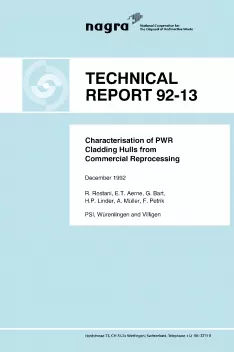
Technical Report NTB 92-13
Characterisation of PWR Cladding Hulls from Commercial Reprocessing
Within the framework of the EC characterisation programme COQUENSTOCK and the cooperation agreement between Nagra and the CEA, PSI received 2 kg of leached hull residues (hull and structure material debris) from the UP2-400 reprocessing plant in La Hague for radiochemical investigation.
The contaminated and activated hull material originated from a fuel element of the PWR Obrigheim (Germany), which had an average burn-up of 30 GWd/tU. The spent fuel from the chopped fuel element was dissolved in a static dissolver and then rinsed.
Because of the significance for repository safety analyses, the emphasis of the investigations was placed on measuring the α-isotope composition, the actinide concentrations and the local distribution of these on and in the fuel element hulls.
The main activity in the cladding waste can be attributed to the presence of typical activation products in the fuel element structural materials, which consist of Inconel and stainless steel. After a cooling period of five years, the gamma dose rate from these components is generally more than a factor of 30 higher than that from the Zircaloy-4 fuel rod fragments (Table a). The Co-60 activities vary very widely and reflect the differing content of Co-59 in the non-irradiated structural material. In the case of the Zircaloy hulls, the activity is dominated by Sb-125 from the Zircaloy alloying element tin, and by fission products (Table b). The fission products significantly contaminate the structure material in the dissolver.
The isotope dilution analysis following chemical dissolution of the Zircaloy hulls gave uranium concentrations of 400 to 2,150 mg U/kg Zry, with a mean value of 1,130 ppm. The Pu/U weight ratio of 1:85 is found to be relatively constant over the whole contamination range. It is also worth noting that the U- and Pu-isotopic composition remains constant in spite of local differences in burn-up (form factor = 1.15). In addition, the Pu-isotopic composition on the Zircaloy hulls is not found to reflect the values which are expected for undissolved, adherent fuel, so that deposition processes during the fuel dissolution can be taken as determining the α-contamination of the hulls.
Based on α-spectrometry measurements, it can be stated that, besides the Pu isotopes, the nuclides Am-241 and Cm-244 contribute more than 30 % to the mean total α-activity of 6.7 mCi/kg Zry (= 250 MBq/kg Zry) (Table b).
The activity distribution on and in the Zircaloy hulls was investigated using αautoradiography and secondary ion mass spectrometry (SIMS). The Zircaloy surfaces are completely contaminated both inside and outside. Due to the dissolution and flushing processes, the outside surface has a relatively even αcontamination while, on the inside surface (in contact with the fuel) localised areas with very high contamination occur frequently. These areas are formed by residues of dried fuel solution and are particularly significant for trapped residues in pinched or deformed hulls. These localised areas are characterised by the loosely bound nature of the α-deposits.
Qualitative SIMS depth profile analysis showed that uranium is deposited or emplaced almost exclusively on the surface and, to a small extent, in the thin oxide layer. Compared to this, the fission products penetrate further into the inner surface due to their recoil energy. This implanted beta, gamma activity is significant and very difficult to remove by rinsing. On the other hand, the primary α-contamination on the inner surface was largely removed by the very efficient fuel dissolution process. The secondary contamination on the hulls, especially on the inner surface, arising in the dissolver could be washed out to a greater extent by using a more suitable rinsing procedure which takes into account hull deformation and the somewhat rough surface structure. On the outside of the hulls, the concentrations tend to be regular and fit the concept of a purely secondary surface contamination.
Since the contamination mechanism for the fission products is different to a certain extent from that for the actinides, it is understandable that the correlation between the actinides and the fission products is limited. When characterising the cladding waste, Cs-137 is therefore not really suitable as a reference nuclide for the adhesive, fissile material.
